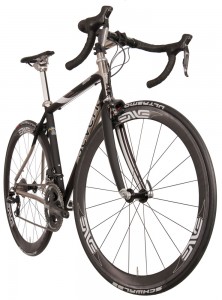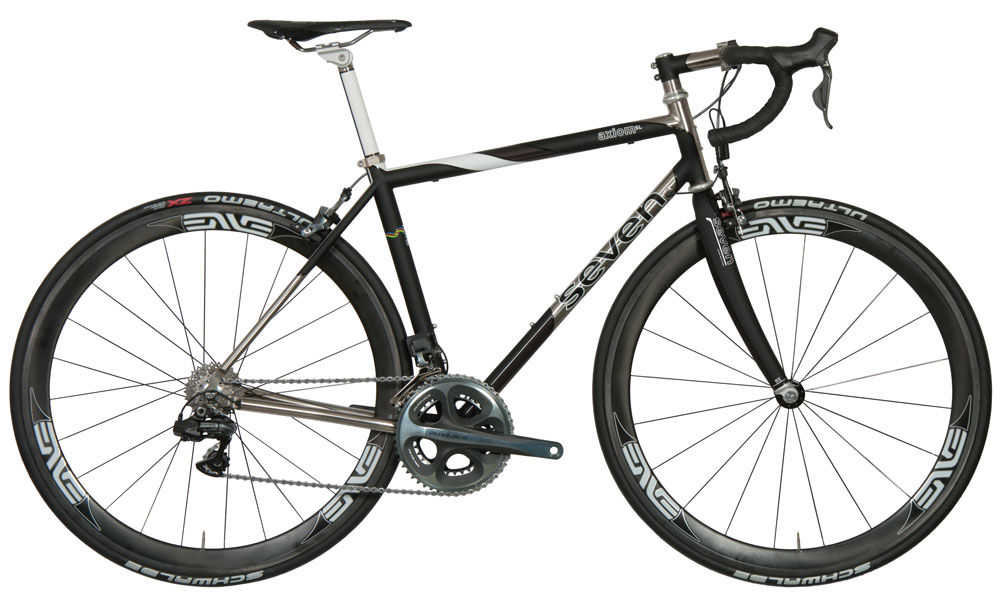
We talk about customization a lot, but the word itself means so many different things to so many different people it becomes sort of meaningless, another bike industry buzz word that flies around but seldom lands. We thought it might be a good idea to explain howWE customize a bike using the Bicycling magazine test bike we built for Joe Lindsey as an example.
The truth is we didn’t want to send Joe an Axiom SL, initially. When he got in touch with us we were just putting the finishing touches on the 622 SLX, and the opportunity to put our newest creation into a big magazine was exciting.
But Joe didn’t want a purpose-built speed demon. He was more interested in versatility and timelessness, so we arrived, together,at the Axiom SL. It’s light, but not the lightest. It can race, or it can tour. And it showcases our double-butting process, one of the ways we tune ride characteristics to the rider.
Joe filled out our Custom Kit, a small pamphlet we developed to capture all the ideas a rider has about his or her new bike, and also to learn some things the rider might not mention otherwise. It starts with personal information, name, age, and weight, but also occupation and geographic location. We ask about what people do, so that we can get a sense for their everyday ergonomics. Do they sit at a desk all day or are they more active? Clues like this tell us a lot about how a rider will approach their new bike. Where they live gives us some idea about the roads they’ll ride, the hills or the flats, the quality of the surfaces.
Next come basic body measurements: height, inseam, arm length, and more. We can already begin to work on frame geometry from this simple data. Joe is 5′ 9″ – 5′ 10″ and weighs 140lbs. His inseam is a shade over 32â€. We noticed at this point that his arms and inseam were slightly below average. We started thinking about a sloping top tube, both to add stiffness to the frame and to give him better stand over clearance.
We also ask about riding habits. How many years in the saddle? How many hours a week? Typical cadence? As well as some other things about riding style. From this we divine some clues about the stiffness of the frame and the dynamics of the various tubes.
Joe has been riding for over 20 years. He averages 10 hours a week on the bike, and his normal cadence is between 70-90rpm. Joe rides in Colorado. He does a lot of climbing and sees a lot of dirt roads. As an experienced rider, Joe climbs both seated and standing. He pedals through corners. He knows his way around a bike.
Joe told us he was looking for a “neutral feel that’s responsive but not nervous.” To the average person on the street, this statement might be cryptic. To a bike designer, it’s gold.
From the Custom Kit we also learned that Joe carries a neck injury, and has some pain in his shoulders on longer rides. His flexibility is good, but not exceptional.
Joe’s every day ride is a steel Pegoretti Duende. That bike’s handling is pretty close to his ideal, but it’s a little more plush than he likes, not quite stiff enough. From a fit perspective though, his Pegoretti is perfect. It gives him good vertical compliance, which is to say it absorbs vertical forces without flexing horizontally, and he also has ideal reach to the hoods and perfect barheight.
What we learn here is that we can emulate certain aspects of that bike’s fit, though we never set out to duplicate another bike exactly. We always want to know what we can improve. To that end, we always ask if the rider is open to suggestions about positional changes, especially if they’ve had injuries or chronic pain.
Joe told us he was very open to our ideas. We lowered his saddle and raised his bars a bit. We stretched him out, for a longer overall reach. Because he told us his Pegoretti’s handling was a little more twitchy than he liked, we shortened the fork rake on his Seven to give more trail, and therefore more stability.
It would be natural to assume that, in order to give Joe the added drivetrain stiffness he wanted, we would select a thicker, less aggressively butted tubeset. But, it’s easy with a rider as light as Joe to over-stiffen that way. In fact, we didn’t end up tweaking his newtubeset at all. We went with our standard SL tubeset, which is plenty stiff for lighter riders. We allowed the sloping top tube and our signature s-bent chainstays to give him the responsiveness he was looking for. This approach also allowed us to keep the weight down.
The rest of the Custom Kit asks very specifically how you want your bike to handle, how stiff you want it to be in the drivetrain, how vertically compliant you like your ride and how important the weight of your frame is to you. Many of these topics have already been covered in other ways in the kit, but asking again, and more specifically, we validate what we’ve already been told. This helps us weed out misperceptions and misinformation.
Because Joe selected the Axiom SL, a bike most people have seen both in magazines and on the road, we wanted to do something special with the paint. People have come to view the Axiom SL as a classic American bike, which is very flattering, but our challenge is to keep giving it a fresh look, and that’s what we aimed for with Joe’s bike.
To showcase our capabilities, we decided to use three different and contrasting finishes, polished Titanium, matte black and high gloss white paint. We also chose to paint the stem, fork and post to extend the design away from the frame and give the bike a more integrated look
Finally, Joe asked for a Shimano Di2 electronic component group to finish off his bike. For his bike, we took a unique approach to routing and battery placement that has worked well for us. Holes at the top of the down tube and one at each derailleur cover the wiring. We’ve also had success mounting the battery in the seat tube. This approach gives the battery a more water-proof home and maintains the sleek lines of the frame.
The complete bike yielded the review highlighted here , and for us, more than validating what we can do when we set out to make a show piece bike, Joe’s experience highlighted for us what we can do when we stay true to the basic processes that have sustained us from the beginning.

